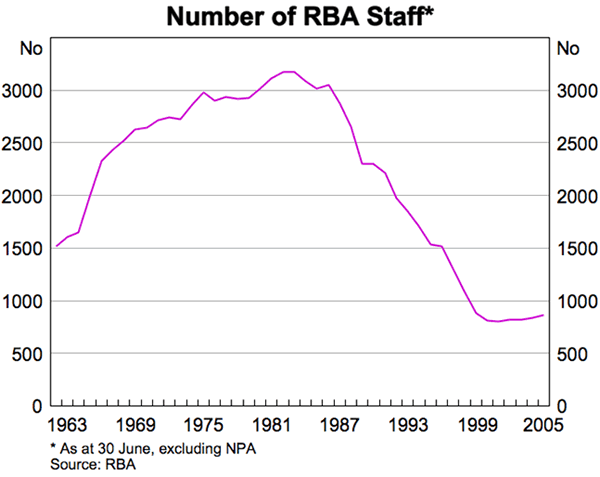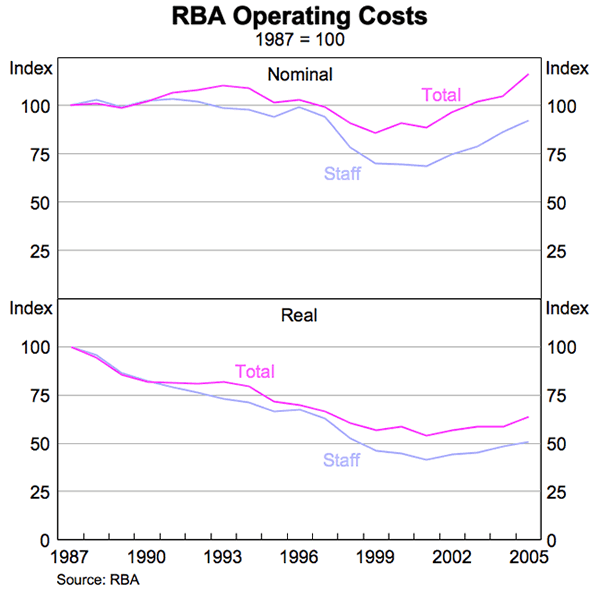Reserve Bank of Australia Annual Report – 2005 Management of the Reserve Bank
Staff numbers rose in 2004/05 with an increase in graduate recruitment, mainly in the policy areas. In addition, more resources were devoted in Note Issue to monitoring the quality of currency notes, and in IT to short-term, project-related work. As the Reserve Bank resumed operational responsibility for facilities at NPA, there was a small increase in related staff, although this was more than offset by a reduction in maintenance staff at NPA. Overall, staff numbers rose from 833 at 30 June 2004 to 860 at 30 June 2005.

Staffing policies continue to be reviewed to ensure that staff with appropriate qualifications and of the required standard are attracted and retained. Reflecting the focus on financial policy, the Reserve Bank's recruitment efforts are concentrated on university graduates of the highest quality in disciplines that are directly relevant to monetary policy and financial system stability. With the growing operational importance of IT systems and financial reporting, the Reserve Bank has more recently also sought graduates of high quality in these disciplines. In recognition of the competition for well-qualified recruits, considerable effort is directed to maintaining strong relationships with universities, professional associations and graduate communication networks.
Forty graduates, representing a third of all new employees in 2004/05, began the Reserve Bank's two-year Graduate Development Program. These graduates were employed mainly in policy areas. Twenty-nine staff completed the Graduate Development Program in 2004/05, all of whom were offered and accepted ongoing employment.
The Cadetship scheme has been particularly effective as a recruitment vehicle. This program provides two months of work experience, before the university honours year begins, for high-potential students who have completed three years of undergraduate study. The program provides financial support during the honours year for those who accept a place on the next Graduate Development Program. In 2004/05, 16 of the new graduates had previously been cadets.
While the intake for other positions at junior levels has been relatively low for a number of years, such positions are often filled by trainees who have completed the Australian Governments' New Apprenticeship and Traineeship System, in which the Reserve Bank participates. In 2004/05, five of the seven graduates from this program, which combines on-the-job training with classroom learning, were offered and accepted permanent employment. Fourteen new trainees, including in IT and print design, have recently commenced the 2005 scheme.
Formal and informal training and development programs are aimed at improving the skills of staff; more than half already have degree qualifications and almost a fifth have post-graduate qualifications. Employees who seek to improve their qualifications are supported in a number of ways, including through the Post-Graduate Study Award (PGSA) Program, which provides financial assistance to a few of the most capable staff to allow them to undertake full-time post-graduate study in relevant disciplines at universities in Australia and abroad. At 30 June 2005, six staff were studying overseas under the PGSA Program. Employees who receive these awards are required to reimburse costs if they resign during the term of the award or if they leave the Reserve Bank before completing an agreed period of work after they return from their studies. Financial assistance to obtain relevant qualifications via part-time study is also available. Eighty-one members of staff were supported in this way during the year, the majority seeking post-graduate qualifications. Tuition fees are met on the successful completion of course subjects.
The performance management process encourages managers and supervisors to identify training and development needs of individual employees. A high level of investment in internal and external vocational training is maintained. Transfers to overseas and regional offices, and to other organisations, provide broader experience and develop skills. During 2004/05, there were secondments to the BIS, ECB, Bank of England, Australian Treasury, Australian Taxation Office, APRA and its counterpart in the UK, the Financial Services Authority.
Staff turnover and retention rates continue to be monitored closely, particularly for graduates, to help ensure a sound return on the investment in training and development. Turnover of graduates in the Reserve Bank is similar to that for graduates in comparable organisations.
A key factor in attracting and retaining staff of suitable calibre is the ongoing process of reviewing the terms and conditions of employment. Almost 80 per cent of staff in the professional and managerial stream are now employed on individual contracts, which provide greater flexibility to match remuneration with responsibility and performance. Short-term contracts are also used to recruit staff when the need is specialised and not expected to be ongoing. Nineteen IT staff, for example, are employed on short-term contracts. The move to individual contracts for staff is voluntary. No staff member on contract has a housing loan from the Reserve Bank. Comparison of remuneration with positions of similar responsibility in the private sector is based on advice from remuneration consultants, with market benchmarking undertaken through participation in industry-based salary surveys.
For other staff, the enterprise bargaining agreement (EBA) provides the basis for changes to remuneration and other employment conditions. The most recent agreement provides greater scope than in the past to reward staff according to performance within existing budget constraints. Staff covered by this agreement received an annual salary increase of 4 per cent in November 2004, and were eligible for a performance payment. Staff on contract received, on average, the same annual increase as staff covered by the EBA. Discussions are currently under way for the next enterprise bargaining agreement.

A key initiative this year was the participation by the Reserve Bank in a joint-venture childcare facility in the Sydney CBD. This facility provides 20 places for pre-school-age children of staff. Management of the centre is contracted to a specialist, non-profit company, which has been involved in early childhood education for many years. The conditions of the joint-venture agreement satisfy relevant taxation tests for staff to pay for the childcare from pre-tax salary. A Parent Room has also been established in Head Office to assist staff, especially with very young children. Another initiative to assist with caring responsibilities has been the replacement of existing sick and carer's leave arrangements with a combined entitlement, allowing staff to take up to 10 days leave per year for caring purposes. This is in addition to existing arrangements for paid maternity leave and part-time work.
Operating Costs
Several factors worked to increase operating costs in 2004/05, including a number of upgrades to important operating systems. The major improvements include replacement of the trading system for both international and domestic transactions with an integrated trading, settlements and accounting system; and further development of RITS, the core of the high-value interbank payments system, to enhance its access, security and backup functions. These projects will continue into 2005/06. The leasing of space for a temporary business resumption site, and preparatory work for construction of a permanent site, due to be commissioned in mid 2007, also added to costs. In addition, the Reserve Bank incurred expenses of about $3½ million on litigation in relation to payments system reform proposals. If the Reserve Bank successfully defends these proposals, it could recover some of these costs.
| 1997/98 | 1998/99 | 1999/00 | 2000/01 | 2001/02 | 2002/03 | 2003/04 | 2004/05 | |
|---|---|---|---|---|---|---|---|---|
| Staff costs | 77.7 | 69.1 | 68.7 | 67.7 | 73.9 | 77.8 | 85.5 | 91.4 |
| Other costs | 47.2 | 49.1 | 56.1 | 54.1 | 58.4 | 62.7 | 58.6 | 68.8 |
| Underlying operating costs | 124.9 | 118.2 | 124.8 | 121.8 | 132.3 | 140.5 | 144.1 | 160.2 |
| Cost of redundancies | 20.7 | 18.4 | 9.3 | 2.6 | 3.4 | 2.6 | 0.2 | 0.2 |
| (a) Costs associated with the ongoing operation of the RBA, excluding NPA | ||||||||
The rise in staff costs reflected an annual increase in base salaries of 4 per cent in November 2004, plus some performance payments. Average staff levels in 2004/05 were slightly higher than those of the previous year. While nominal staff costs remain about 10 per cent less than their level at the peak in 1990/91, in real terms they are still around half their peak.

The core policy areas of monetary policy and financial system surveillance account for more than half of the Reserve Bank's costs, a higher share than was typical until recent years. The apparent shift in resources towards policy areas mainly reflects the fact that note issue and banking operations are now much smaller in absolute terms than they were, although there has also been some increase in resources in the monetary policy and financial stability areas. Policy groups aside, the remaining costs are now spread fairly equally between note distribution, banking and registry operations, and the provision of settlement services, including the in-house operation of RTGS. (Details on these activities are provided in the chapter on ‘Business Services’.)
Facilities Management
The Reserve Bank owns a number of properties in Sydney, Melbourne and Canberra for business reasons, and also leases premises for regional representation in Adelaide, Brisbane and Perth. Within Head Office, all of the vacant space made available by the recent consolidation of functions has now been leased on commercial terms to tenants, earning gross rental income of about $1.9 million in a full year.
As noted in the chapter on ‘The Reserve Bank in the Community’, the construction phase of the Museum of Australian Currency Notes was successfully completed and the museum was officially opened in late February 2005. The museum is located on the ground floor of Head Office and provides a high-quality display, with strict environmental controls to protect and conserve the exhibits, and a multi-purpose meeting room. There is improved access for people with disabilities, both to the banking chamber and the museum.
In late 2004, contracts were exchanged for the purchase of 1.48 hectares of vacant land in outer metropolitan Sydney on which to construct a business resumption site. Following the exchange of contracts, a design team was appointed to prepare a concept design for the facility. In accordance with the provisions of the Public Works Committee Act 1969, the project was referred to the Parliamentary Standing Committee on Public Works for consideration and report. The Committee's report, which followed a public inquiry, recommended that the works proceed at an estimated cost of $38 million. The recommendation was endorsed by Parliament in late June 2005. This endorsement has enabled contract documentation to commence for an anticipated start to construction early in 2006.
The Reserve Bank has established a number of environmental policies and programs that assist in reducing waste and the use of energy and other resources. Over the past decade, the Energy Management Program has led to a reduction in energy consumption in line with targets of the Australian Government. Other environmental initiatives, including enhanced waste-paper recycling practices, have also been adopted and included in procurement policies.
Consultancies
In common with other large organisations, the Reserve Bank employs outside contractors or professional service providers to carry out specific tasks where necessary, and also, from time to time, uses consultants. A consultant is a person or organisation that investigates particular issues and then provides independent advice.
| Name | Project | Cost ($, excl GST) | Purpose |
|---|---|---|---|
| Mallesons Stephen Jaques | OH&S Liabilities | 10,774 | Legal advice on the OH&S Act 1991 |
| Hay Group Pty Limited | RBA Personnel | 48,909 | Market testing of remuneration of RBA staff |
| Clayton Utz | Reform of EFTPOS System | 120,433 | Legal advice on reform of the EFTPOS system |
| The Asset Partnership | NPA Passport Production | 53,600 | Risk review of passport production |
| Mercer Human Resources Consulting | NPA Personnel Practices | 38,200 | Market benchmarking of NPA remuneration |
| (a) Costing $10,000 or more | |||